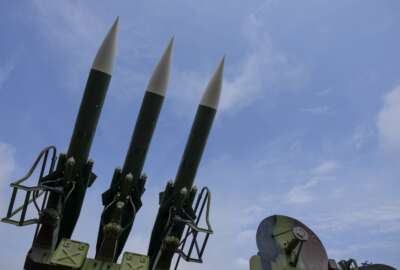The Defense Department explores how to make hydrogen fuel on the go
"The unique solution that we've created combines atmospheric water generation where we suck the water from the humidity in the air," Lanson Jones said.
With all of the talk about electric vehicles, you might not realize another promising non-fossil fuel alternative is out there. Hydrogen. It’s a great fuel in liquid form. The challenge is generating it. The Defense Innovation Unit has been exploring ways to make hydrogen fuel locally, where it’s consumed and it awarded a contract for mobile hydrogen generation. Joining the Federal Drive with Tom Temin. DIU program manager Andrew Mawdsley. And from NovaSpark Energy, Lanson Jones.
Interview transcript:
Tom Temin Okay. And let’s start with you, Mr. Mawdsley, from DIU. Tell us about the high tech, very clever name, hydrogen tech, high tech program. What’s this all about to begin with?
Andrew Mawdsley Yeah, absolutely. So high tech, acronym stands for hydrogen at the tactical edge of contested logistics. And like many other programs that DIU advances, we partner with the military services to really act on behalf of the joint force and combatant commands, to identify areas where there are commercial technologies out there that we can really leverage and prototype to get in the hands of the war fighters much faster than kind of conventional methods. And so in this case, we’re working on behalf of the Marine Corps Expeditionary Energy Office, as well as the Naval Information Warfare Center Pacific Network Pack, and really advancing this requirement to identify a way in which we can generate hydrogen at the tactical edge, and taking water converting it into hydrogen to be able to power different unmanned aerial systems, vehicles, balloons, small unit power capabilities are really strategically important to some of the operational planning that is going on across the entire joint force.
Tom Temin Sure. So this is part of that bigger picture of energy independence and getting away from fossil fuels, which have a big logistics chain. This would be a way of generating this fuel right there on the spot.
Andrew Mawdsley Absolutely. So many of the the strategic planning circles leaders talk about the contested logistics challenge whereby a lot of the war gaming suggests that in a contested environment, there are vulnerabilities and limitations in terms of the fuel supply chains. And so the more and more we can make different kind of remote forces, energy resilient and less dependent on those fuel supply chains, the more we’re going to be able to persist in certain operations in a distributed environment.
Tom Temin All right. And let’s move to Mr. Jones from NovaSpark Energy. What is the challenge in making hydrogen locally? And what is the form in which it’s supposed to end up? In other words, we don’t want a whole bunch of miniature hindenburg’s out there.
Lanson Jones Yeah. So the unique solution that we’ve created combines atmospheric water generation where we actually suck the water from the humidity in the air, but we uniquely do it using a technique that uses about 30% less power. So we get the water more efficiently. We only need 30% humidity, which is most of the availability on earth has 30% humidity, and then we combine it with electrolysis. But we have a unique electrolysis that allows you to throttle with renewables, and turn it on and off so you can create on the spot on the go, you can turn it off and then move the mobile unit, and then set it back up and quickly start creating hydrogen again. And we store it at gaseous high pressure. So we have this 35 bar, and then we have a hydraulic boost technology that takes it from 35 bar to 300 bar and 700 bar. And the safety issue, we can actually with our tanks, they are rated for a 50 cal bullet and still be safe and be able to handle that. And we’re working on other solutions that could even possibly store hydrogen at standard temperature and pressures.
Tom Temin Sure. And let me just ask this about the whole idea of hydrogen energy. Does less energy go into making it than you get out of it, or is it an ultimate loss of energy even though you have a fuel that will power something?
Lanson Jones So there is a loss of energy, but those efficiencies that are being worked on. In our R&D lab, we have unique methodologies that we’re testing right now to increase those efficiencies. One is bubble free technology that allows much higher efficiency. We’re talking about 95%. A company out there called High Stata has already proven you can do this, and we’re working on ways to do it even better. And it’s 95% efficiency, and then you require power to pressurize it and that obviously consumes energy. That’s why we’re working on things that can store hydrogen at standard temperature and pressure. And that’s our roadmap in the long run to make it so you have the highest efficiency possible, and you can create the most amount of hydrogen possible with the energy available.
Tom Temin We’re speaking with Lance and Jones. He’s chief innovation officer at NovaSpark Energy, and with Andrew Maudsley, a program manager at the Defense Innovation Unit. And Andrew, what is the envisioned source of power for the hydrogen generator such that you don’t stay in the logistics tail of fuel problem?
Andrew Mawdsley Yeah, exactly. So one of the advantages of a system that we’re sourcing is the ability to use renewables onsite or at the tactical edge, as we call it. So in this case, the NovaSpark generator using a combination of solar and wind power to generate the power for this system to produce the hydrogen. So then as a result, we’re just not dependent on these fuel supply chains to persist in operations. You can imagine the ability to have distributed units with this kind of a system that can persist in certain critical operations in support of any type of effort to deter, defend and fight a war if necessary.
Tom Temin And the resulting hydrogen and the propulsion systems that consume it. Is this similar to what we’ve seen in rare instances so far? There have been some, I guess, almost experimental automobiles that use hydrogen. I don’t know what the technology is, but it fits under the hood of a car. Is this the same basic technology here?
Andrew Mawdsley Yeah, Well, maybe, Lance, in a way, and a little bit more assessing. What he would say is the similarity between their solution and the type of things that it powers as well as vehicles. But I would comment just a few call it tactical advantages of leveraging fuel cell platforms, as we call it, for military applications, because they are a little bit more unique than vehicles. But some of the things that are very attractive to military planners about leveraging fuel cells are the longer flight times or drive ranges where using an unmanned aerial system or like a tactical vehicle that operates on a fuel cell. Additionally, for these platforms or systems, there’s a much lower electronic signature, which is pretty important in certain military environments. There’s a lower maintenance requirement for sustaining operations of these capabilities. And like we’ve kind of discussed before, higher energy resilience, and most importantly, reduce dependance on fuel supply chains which are vulnerable to disruption and attack in a contested logistics environment.
Lanson Jones In this unique solution, yes, a fuel cell and gas used for tank storage is how the current hydrogen cars are modeled, and with our unit is very similar to that, except we’re creating the actual hydrogen on the spot. So we’re vertically integrating all aspects from getting the water, getting the power, splitting that water to create hydrogen through electrolysis process and then we storing in the gaseous form. And like I said earlier, we use a unique hydraulic boosting technology and that allows for the highest reliability and the highest safety for putting it under high pressure. And it also uses the lowest amount of energy.
Tom Temin A couple of questions here. One for Andrew. You mentioned that with fuel cells, you’re going to have longer flights and drive distances. Is that relative to battery powered, which is kind of a dead end for flight or any kind of a heavy vehicle or relative to the conventional ways they’re powered now?
Andrew Mawdsley Yes, for sure relative to battery power. And then regarding in comparison to traditional bulk fuel might really vary. But again, like this is kind of a unique value proposition for military applications. We’re really trying to get around that dependency and the expectation that we’re going to be able to ship fuel from various locations and distribute it to different areas in theater. So we’re just trying to create innovative solutions that we know exist in the commercial market, and really adopt them for military applications.
Tom Temin Lanson, and how big is this thing? Like, is it the size of a washing machine, the size of a semi-trailer, or what?
Lanson Jones Its equivalent to the size of a small generator? It actually fits on one of the smallest military and civilian trailers you can purchase. And obviously it can be scaled to be bigger to create even more hydrogen at scale.
Tom Temin All right. And Andrew, what’s the timeline here? You have a prototype. What is the hope for how this gets turned into a program of record or into operations?
Andrew Mawdsley Yeah. Great question because at DIU, ultimately our goal is yes to prototype, but also to field. And we’ve got transition capability to the services to be able to leverage going forward. But for this program, we had two vendors that received contracts and are prototyping over the course of this calendar year. Both are doing incredibly well and ahead of schedule, set to complete production this year. And then we’re going to be demoing these prototypes in field exercises the first half of calendar year 2025. And really from that point, looking to find a way to transition that capability, and really equip our warfighters with this this new added capability.
Copyright © 2025 Federal News Network. All rights reserved. This website is not intended for users located within the European Economic Area.
Tom Temin is host of the Federal Drive and has been providing insight on federal technology and management issues for more than 30 years.
Follow @tteminWFED






